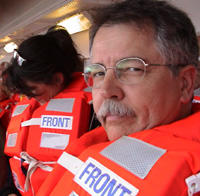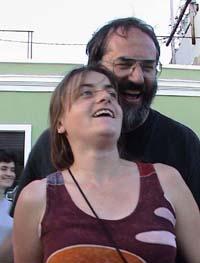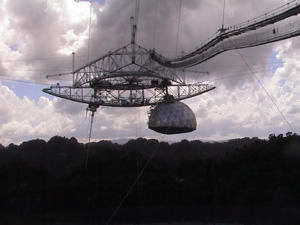

Food, drink, sun and socializing onboard Linux Lunacy.
After the third Bloody Mary, it doesn't matter what the hell Richard Stallman says. Well, actually it does. The man's uncompromising certitude fronts a set of ethical and technical convictions (not to mention achievements) that have so arguably shaped the world we'll never stop arguing about them. But arguing was not the first order of our week at sea on a Geek Cruise around the Eastern Caribbean. Schmoozing was. Also eating, drinking, dancing and hanging out on various decks and lounges between lectures by V.I.G.s and forays to ports of call.
RMS was good company. So were Eric Raymond, Jon “maddog” Hall, Dan Connolly, Michael Johnson, and the hundred-plus other geeks, family members and affectionate affiliates who shared the floating venue.

The author at a precruise security meeting.
The cruise was created by “Captain” Neil Bauman, who is also the impresario for Java Jam, Perl Whirl, Mac Mania and other floating conferences for various computing constituencies. This one was cosponsored by Linux Journal, which provided two of the speakers (At the Forge columnist Reuven Lerner and a certain Senior Editor who writes the Linux For Suits column), plus a number of other cruisers, including: Richard Vernon, our Editor in Chief (whom I referred to in my talk as Señor Editor, owing to his Ph.D. in Hispanic Literature); Carlie Fairchild, our VP of Sales & Marketing; Martin Seto, our Northeast Regional salesdude; and Phil Hughes, our publisher and resident Geek in Chief. LJ families also brought along a total of seven kids. Adult forms of children, however, accounted for about half the remaining guest list.
The trip was a trip.
We left Fort Lauderdale under a balmy and overcast sky on Sunday, October 21. The light was perfect for hundreds of near-simultaneous digital photographs, snapping silently on the forward deck. The ports of call, all visited over the next week in perfect weather on calm seas near the end of the hurricane season, took us through the Bahamas, Puerto Rico, St. Thomas, in the U.S. Virgin Islands, and back through the Bahamas again. Our vessel was the M.S. Maasdam, an eleven-deck 54,000 ton ocean liner that sails under the fastidious stewardship of Holland America Lines.
Built to work as a round-the-clock eating, drinking, swimming, formal dining and entertainment experience, a cruise like this is more about relaxing than touring. The shore visits are almost interruptions: the travel equivalent of hors d'ouevres, even for standard cruise guests of the Love Boat variety. For herds of geeks on the water, however, the whole thing was more about hanging out and talking techno-trash on a near-constant basis.
Designed by Neil as a floating industry conference, the cruise featured a curriculum of breakouts and keynote speeches. On Monday, for example, our first full day on the cruise, we spent the morning docked in Nassau, then followed with a noon-7:45pm series of six different talks, all at sea, en route to San Juan. These included:
Jon “maddog” Hall on Linux pros and cons
Reuven Lerner on mod_perl
Eric S. Raymond on “The Great Brain Race”
Steve Roberts on “The Technomadic Life”
Dinner followed. Two nights out of our seven at sea were formal, and a major hoot. RMS wore his “power tie” (see pic) one night and an Ethernet cable on the other. And one of the few times I've ever seen Maddog actually appear to exemplify his dangerous name was when he showed up for dinner at our table in a perfectly tailored tux, hair slicked back over his enormous beard, sporting a brass-handled cane that turned out to conceal a small beaker of liquid improvement for the evening's four-course meal. He looked like Diamond Jim Brady.

RMS gives a GNU meaning to power tie.
Some of the most enjoyable talks (all of generous length) were by folks who make creative use of Linux but fall outside the usual range of Linux community hubbub. Chief among these was Steve Roberts, the six-foot-four head of Nomadic Research Labs, which is the corporate expression of his high-profile nomadic life.
You had to be isolated from nearly all media to have remained unexposed to news features about Steve's peripatetic journeys across the country on a series of recumbent bicycles--the Winnebiko I, Winnebiko II and finally the Behemoth--that were each increasingly encumbered by every imaginable technology, and then some. Steve's trend, however, was opposite that of our biological ancestors, since Steve seems to have evolved back toward the sea with his latest Nomadic effort, The Microship Project.
Steve is a Polymath of the First Water. He's an inventor, ham radio operator, circuit board designer and handcrafter of many useful things, all of which he integrates seamfully into vehicles powered by human muscle, sunlight and other natural processes. An interactive schematic of the Microship is here.
Sometime soon Steve and his wife Natasha Clarke will depart for another long trip—an expedition--this one on various US waterways down through the heartland and along various coasts, on his & hers Microships, Wordplay and Songline. (We'll be publishing my interview with Steve—and those with Eric Raymond and Richard Stallman, among others—shortly after we're done transcribing them.)

Steve Roberts and Natasha Clarke will soon take the Microships Wordplay and Songline on the aquatic equivalent of a road movie.
Natasha was a hoot. When I met her at the first of the cruise's countless cocktail parties, and mentioned I lived in Santa Barbara, she yelled “You killed Doug Adams! He never would have gone to a gym in England!” Natasha, who hails from London, knew the late author and shared his pointed sense of humor.
Cruises like this are no place to go for a diet. The boat charges for drinks, but pretty much all the food comes with the price of admission, and in cornucopian abundance. Food seems to wash over you in tides; not only at scheduled meal times (when many geeks took the opportunity to order two or more entrées), but at various snacky intervals. There were formal teas in the two-deck Rembrandt Lounge, hamburger & rib cookouts by the Lido pool, and an ice cream bar on the Lido level that never seemed to close. The long buffets in the Lido dining room, where every seat had an 11th-floor view out the deck's wall of windows, was open to midnight. Room service was also delivered without additional charge, and available around the clock.
The rooms weren't bad, either. We had one of the smallest cabins, and it served our family of three just fine. I've stayed in much tinier rooms in fine French hotels. At the top (just below the Lido), where speakers who registered on time (unlike yours truly, still kicking himself in the head) were privileged to stay, the suites were flat-out huge: over 1100 square feet, including an 8-seat living room area and a vast deck overlooking the ocean.
Most of the action was indoors, but my favorite outdoor discovery was the top front deck, a vast wood-floored space below the forward smoke stacks with their spinning radar, in the wee hours of the night. Alone on that deck in the darkness, with the wind sometimes blasting at near-gale velocities, one stood poised between the immense power of a great ship at sea and the vast mystery of the whole universe. Unlike the land-lit dome that covers civilization, here the sky was Infinitude itself. Stars glowed in the great black Nothing. Spread from one horizon to the other, the wide middle of the Milky Way, in Sagittarius, loomed high overhead. To the Northeast, near Cassiopeia, glowed its nearest neighbor, the Andromeda Galaxy. One could almost sense the perspective, looking from the midst of one galaxy toward another.
Appropriately, our best shore excursion came in Puerto Rico, when we visited the Arecibo Observatory, which looks like an enormous salad bowl held captive in a mountain redoubt and subjected to strange experiments by vast steel spiders. We learned a surprising amount about the system, and the Puerto Rican countryside we drove through to reach it, from our guide, Gonzolo de Leon, who was built like a weight lifter, smart as a whip and much funnier than any of the official on-ship entertainment.

The business end of the Arecibo telescope is a 900 ton contraption suspended from steel bridge cables above a vast bowl of aluminum mesh. That thing draped to the upper right is an aerial catwalk. Perspective: the geodesic “Gregorian dome” hanging like a goiter from the bottom of the platform is 85 feet in diameter and contains control rooms filled with cool computational gear as well as radio transmitting and receiving systems. The dish below is 1000 feet wide.
The telescope itself is a mathematical and engineering marvel that Every geek whose Linux (or whatever) system works its idle hours searching for extraterrestrial intelligence (since we understand the Earthbound shortage all too well ) looks into space through the Arecibo system, where most of the SETI data is collected. Now that I've been reading up on the whole Arecibo/SETI setup, I wish I had done more research before the trip. Maybe one of the SETI scientists would make a good onboard speaker for the cruise. (Hey Cap'n Neal, whaddaya think?)

Leaders of the Free Software and Open Source movements agree respectfully to decline joining a local scientist in worship of native technology.
The only technological disappointment on the trip, but perhaps a fortuitous one, was the ship's Internet cafe, which presented the Net in 640x480 dimensions through a customized Microsoft Internet Explorer browser that cost $.75/minute or $99.95/week to use. Apparently some of us (myself included, I am sure) inadvertently insulted the uniformed professional assigned to assist guests normally far less Net-hip than our contingency. She was not happy with campers who insulted her system verbally—or worse, tried to crawl under the tables and hack into it physically. Using the system, however, made me want to rant through an Arecibo-grade bullhorn at brain-dead info delivery services that never seem to get that the Net is a place no less vast and free than the oceans and the stars:
Earth to Commerce: The Net belongs to nobody because we—your geeks—made it for every member of a species hungry for knowledge and human contact. We have no problem with any hospitality service charging us for access to it. But we don't like it dumbed down, or given a browser interface that's even more commercial than the ones we're already forced to use. Thank you.
Anyway, the net result was to be cast at sea without a Net. For geeks who tend to live in cyberspace (approximately 100% of those aboard), this was a fortuitous blessing that forced far more socializing than might otherwise have occurred. (Late bulletin: Captain Neal has since informed me that future cruises will feature geek-grade Net connectivity, via both wired and wireless links from guest laptops.)

Maddog and RMS (hacking happily on GNU/Linux, we suspect) both strike their best Tux poses on the beach at Half Moon Cay in the Bahamas. RMS's intent, by the way (in his work as well as this photo), is to replace the penguin with a different animal
Spared nearly all temptation to borg into the Net, I found the best part of the trip was hanging out with fellow geeks and colleagues, including luminaries with whom I'd never spent much time, casual or otherwise, in the past. Eric Raymond, for example, is an old pal. But I've never had much hang time with, say, maddog or RMS. Our own Richard (whom I call Señor Editor, owing to his Ph.D. in Hispanic Literature, a degree as marginally relevant to his current occupation as my own background as a marketing dweeb and joke radio personality) has already /article/5590 covered the maddog issue, so I won't go there. I talked with RMS at some length, and have hours of tape to transcribe. You should see it up on the Web as soon as I finish transcribing it and running it past both Richards.
I'm a long way from understanding RMS as well as I would like. But for now I'll just say that it's clear to me that the man has an understanding of software that is extraordinarily deep. His knowledge of what software is and why it matters is too easy to overlook or discredit when we're busy arguing about licensing, business models and the rest of the stuff that soaks up so much geek time—while remaining ironically opaque to those for whom software is just another form of property. That software has properties that resist ownership is just one of the inconveniences that Richard is determined to help the rest of us remember.
Okay, back to the Cruise.
The best purely Caribbean shore trip, by popular acclaim, was St. Thomas, where most of the LJ contingency took a water taxi to a perfect beach on the far side of the island while I hacked away at the keynote talk I would give that evening.

My keynote talk, “Migrating from Antarctica: A Progress Report on Linux in the Land of the Suits,” is here
.
Fortunately I still got a shore trip on Half Moon Cay, our last port of call. Never heard of it? There's a good reason. It was called Little San Salvador until it was bought by Holland America, which renamed it. The company maintains a skeleton crew of just six people on the island. They put much effort into protecting the island's unspoiled nature until the big ships show up and proceed to turn the place into something like a small town on a long curving beach. This state persists until about 3pm, when the crew breaks the set after all the guests have been herded on tender boats back to the mother ship.
On the island I had an enjoyable talk with one of the lifeguards, a woman who spoke with such a perfect native accent that I was sure she hadn't come from our big boat.
“Do you live here?” I asked.
“No. Over there,” she said, pointing at the horizon.
“Where?”
“There. See the island?”
I noticed a narrow margin of gray poking up over the far edge of the blue Atlantic. Then several others broad lumps at some distance to the right and left.
“Oh yeah. Which island is yours?”
“They're all one island: Eleuthera.”
“Really. How big is it?”
“About 110 miles long.”
“How many people live there?”
“I don't know. Maybe ten thousand.”
“Did you come here for the day?”
“Yes. By boat. It's about eighteen miles.”
“Would you ever think about leaving your island, or the Bahamas?”
“Oh no. It's paradise.”